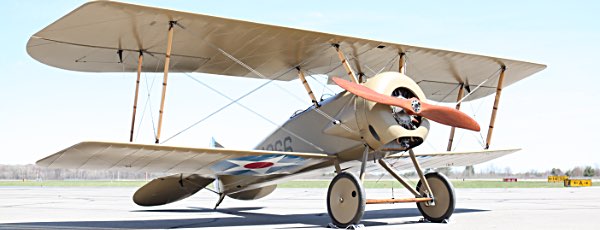- By Dan Veaner
- Around Town
 Print
Print 
On September 29th history will be made when a newly restored Thomas-Morse S-4B Scout, affectionately called 'Tommy', takes off at the Ithaca-Tompkins Regional Airport, 100 years after it was first built in Ithaca. The flight is scheduled September 29th September 29th at a celebration -- Tommy Come Home -- at Taughannock Aviation from 2 to 5pm. Weather permitting, pilot Ken Cassens will fly the plane for what Ithaca Aviation Heritage Foundation members hope will be a huge crowd.
"We're talking to some local marching bands about coming," says the Foundation's Jessie White. "We've invited Women In Aviation, and the girl scouts. Food trucks will be there. We're considering a silent auction in one of the hangars. People could go out of the sun to bid on items, because this is also a big fundraiser for Tommy. After Tommy is flown it is going to be displayed at the new History Center."
Around 40 volunteers led by Don Funke have been restoring Tommy for the past ten years, with around 20 acting as the core restorers. They stripped the plane down to its spruce skeleton, rebuilding it with as many original fuselage and metal parts as they had, and recovering the fuselage with donated fabric and paint. it was refitted with an original rotary engine.
Sixteen years ago the Ithaca Aviation Heritage Foundation was founded to find a Tommy Scout that could be restored and based in Ithaca, its original home. Members of the foundation followed every lead, finally learning of San Diego Doctor William Thibault, who said it was his 'retirement project' that didn't want to give it up. They returned to Ithaca without a plane.
Foundation members had acquired some Tommy parts after touring one of the buildings the planes were built in, which still exists today. They had built new wings before hearing of Thibault's Tommy, but it turned out they wouldn't need them.
"They started building a plane with these old parts, not knowing if they would find one," says White. "A poster at the Ithaca Festival Parade had a picture of a Tommy, with a plea to help them find one. A little girl in the crowd said, 'Oh look, they want our plane', and disappeared into the crowd. Someone heard that, and they did some sleuthing. They figured out that the doctor in San Diego had a relative that lived in Ithaca. They contacted that relative, and he connected them to his father, the doctor who owned the plane. But he still didn't want to part with it."
A month later Funke met with Thibault while he was visiting Ithaca, and the third time was the charm. Foundation members transported it from San Diego to Ithaca, and began rebuilding it, stripping it down to the spruce skeleton, and lovingly restoring it to its finished glory.
"It's pretty special," White says. "It was a long haul and a lot of convincing to get the plane back here."
At a presentation at the Lansing Community library last June Ithaca-Tompkins Regional Airport Manager Mike Hall pointed out that more airplanes were built in Tompkins County 100 years ago than any place else in the world. William and Oliver Thomas moved their company to Ithaca in 1913, and in 1917 merged with Morse Chain Company to become Thomas-Morse Aircraft Corporation. The Thomas-Morse S-4B Scout that will fly September 29th was built in 1918, one of the many single-seat trainers produced to give fledgling World War I pilots an experience similar to flying actual fighter planes.
That was the heyday of aviation in Ithaca, with the Ithaca airport located in Cass Park (thus the hangar Theatre, which was an actual hangar at the time). But when the federal government put out a Request For Proposals (RFP) for the next generation of trainers the company lost out to what is now the most recognizable name in commercial aviation.
"It was a government owned design and the time came to build more," explained Hall. "They were outbid in an RFP by a company that had access to Sitka spruce, which is what airplanes were made of back then. That company, Boeing, had access to Pacific northwest Sitka spruce. A few years later it was aluminum, made in New York -- that's how close we came when we lost to Seattle."
The highlight of 'Tommy Come Home', of course, will be the historic flight. Cassens, who has logged thousands of hours as a pilot, plans to take off from the grass runway that runs parallel to the paved runway at the Ithaca-Tompkins Airport. Casens, a professional aviator, is also an accomplished airplane builder who won 'Best Homebuilt' for his Starduster II at the Experimental Aircraft Association's (EAA) AirVenture Fly-in.
Funke says Tommy will also be on display at Airport Day and All-You-Can-Eat Pancake Breakfast September 15th. But to see it fly you will have to come to the 'Tommy Come Home' event two weeks later.
White says that an online Eventbrite funding campaign will be added to current donation methods to raise money for ongoing maintenance, and displaying and transporting the plane to the new Tompkins Center for History and Culture location on the Ithaca Commons, which History Center Officials anticipate will open early next year. And to pay for the September event.
"We want this to be free to the public, so anyone who is interested in Tommy can see it being flown," White says. "And it's really special to us because this year is its hundredth birthday."
v14i28



